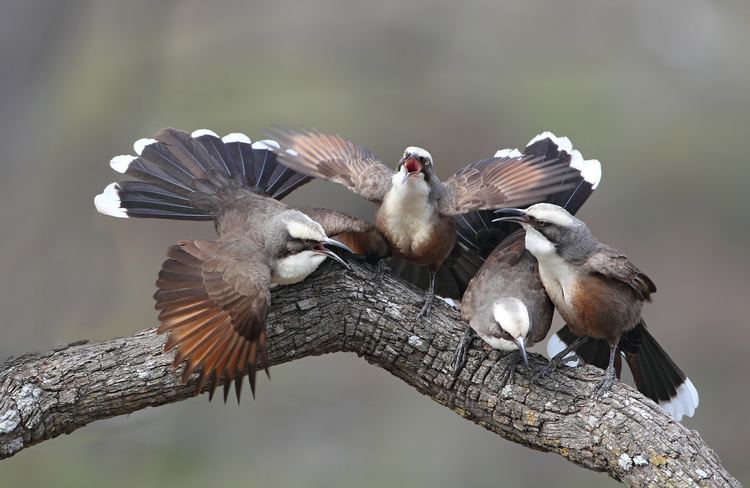Genus Pomatostomus Phylum Chordata Rank Species | Family Pomatostomidae Scientific name Pomatostomus temporalis Higher classification Australo-Papuan babbler Order Passerine | |
Similar Bird, Australo‑Papuan babbler, Chestnut‑crowned babbler, Restless flycatcher, Sittella | ||
Australian native grey crowned babblers calling and bathing
The grey-crowned babbler (Pomatostomus temporalis) is a species of bird in the family Pomatostomidae. It is found in Australia, Indonesia, and Papua New Guinea. Its natural habitats are temperate forests and subtropical or tropical moist lowland forests.
Contents
- Australian native grey crowned babblers calling and bathing
- Grey crowned babbler bird watching in australia with ej birdwatching grey crowned babbler
- Taxonomy
- Naming
- Australia
- States of Australia
- Threats
- References

Grey crowned babbler bird watching in australia with ej birdwatching grey crowned babbler
Taxonomy
Two subspecies are recognised within Australia and New Guinea.

Pomatostomus temporalis temporalis – This subspecies occurs within Australia in the states of Victoria, eastern Queensland (including Cape York), New South Wales and south-eastern South Australia. It is a vagrant or accidental visitor to the Australian Capital Territory. It is also the subspecies believed to occur within New Guinea.

Pomoatostomus temporalis rubeculus – This subspecies occurs in Australia within the states of Western Australia, Northern Territory, western Queensland and a small area of northern South Australia.

The breast color is usually used as the distinguishing morphological character between the subspecies, with a creamy white breast grading to mid-grey in P. t. temporalis and a mid to deep rufous brown breast in P. t. rubeculus. Other differences relate to brow coloration, facial bands through the eye, tail length and overall size. A zone of intergradation occurs between the two subspecies in north-central Queensland.
Naming
A number of alternate names have been provided for the grey-crowned babbler.

Australia

There are numerous lists of threatened fauna from within Australia. The official list of threatened species on the Australian Environment Protection and Biodiversity Conservation Act 1999 does not consider the grey-crowned babbler (either as a species or subspecies) to be threatened.
From other sources, the national status of the grey-crowned babbler varies. The eastern subspecies is increasingly being considered threatened, although not by all:
States of Australia
The conservation status of the grey-crowned babbler varies from state to state within Australia. For example:
Threats
The key process that has led to the decline of the eastern subspecies of the grey-crowned babbler has been the historic loss and fragmentation of its preferred woodland habitat. Grey-crowned babblers generally have a poor ability to immigrate across unsuitable habitats. As a consequence of fragmentation, breeding success and groups sizes decline. Babbler groups are more susceptible to stochastic events leading to local extinction from a fragment. Once a fragment has lost its population of grey-crowned babblers, natural recolonisation rarely occurs because of its poor dispersal ability.
